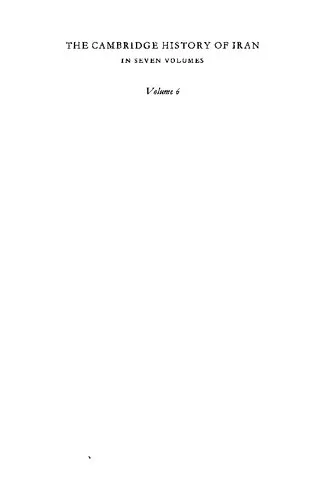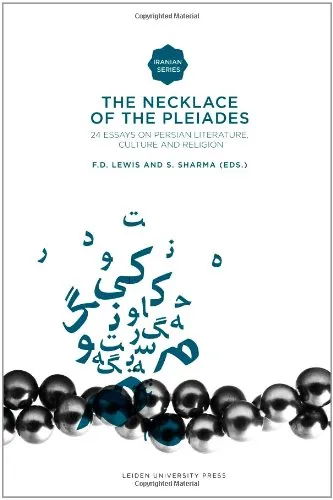The Cambridge History of Iran Vol. 6: The Timurid and Safavid Periods
4.9
بر اساس نظر کاربران

شما میتونید سوالاتتون در باره کتاب رو از هوش مصنوعیش بعد از ورود بپرسید
هر دانلود یا پرسش از هوش مصنوعی 2 امتیاز لازم دارد، برای بدست آوردن امتیاز رایگان، به صفحه ی راهنمای امتیازات سر بزنید و یک سری کار ارزشمند انجام بدینکتاب های مرتبط:
خلاصه تحلیلی کتاب
کتاب The Cambridge History of Iran Vol. 6: The Timurid and Safavid Periods اثری مرجع و تحلیلی است که به بررسی جامع دو دوره مهم و اثرگذار بر تاریخ و فرهنگ ایران میپردازد. این جلد از مجموعه کمبریج، حاصل همکاری پژوهشگران برجسته و متخصصان تاریخ ایران است و تمرکز آن بر بازخوانی تاریخ سیاسی، اجتماعی، اقتصادی و فرهنگی دو سلسله تیموری و صفوی میباشد.
ساختار کتاب بر اساس فصلهای موضوعی تنظیم شده است تا خواننده بتواند علاوه بر شناخت وقایع تاریخی، به درک روندهای کلان و تحولات فکری و هنری این دورهها نیز دست یابد. بهطور خاص، دوران تیموریان با ویژگیهای هنری، معماری باشکوه و مراکز علمی زنده معرفی شده و عهد صفویان با تثبیت تشیع، شکوفایی هنرهای تزئینی و تحکیم قدرت مرکزی مورد تحلیل قرار گرفته است.
تکیه کتاب بر منابع معتبر و ارجاعات علمی، آن را به مرجعی قابل اعتماد برای پژوهشگران، دانشجویان تاریخ و علاقمندان جدی به مطالعه ایران پیشمدرن تبدیل کرده است. علاوه بر آن، استفاده از اصطلاحات علمی و بهروز در حوزه Iranology باعث شده است تا این اثر همچنان تازگی خود را حفظ کند.
نکات کلیدی و کاربردی
یکی از ارزشهای بزرگ این جلد، رویکرد تطبیقی و تحلیلی است که نهتنها رخدادهای تاریخی را روایت میکند، بلکه ارتباط میان سیاست، جامعه و فرهنگ را در این دو دوره روشن میسازد. خواننده میآموزد که چگونه ساختار قدرت تیموریان و صفویان بر تحولات اقتصادی و هنری اثر گذاشت.
نگرش کتاب به تحولات مذهبی، خصوصاً نقش تشیع در دوران صفوی، کمک میکند تا فهم عمیقتری از هویت و انسجام اجتماعی در ایران شکل بگیرد. همچنین بررسی روابط خارجی و دیپلماسی این سلسلهها، دیدگاهی گسترده درباره جایگاه ایران در نظام بینالمللی آن زمان ارائه میدهد.
برای پژوهشگران، این حجم از جزئیات و تحلیلهای چندجانبه فرصتی بینظیر برای مقایسه و بازنگری مفروضات تاریخی فراهم میآورد. افراد علاقهمند به هنر و ادبیات نیز با بخشهای تخصصی درباره معماری و نسخههای خطی ارزشمند این دوره، بهره فراوان خواهند برد.
نقلقولهای ماندگار
این کتاب حاوی تحلیلها و جملات برجستهای است که میتواند الهامبخش پژوهش و مطالعه بیشتر باشد. برخی از گفتهها، جایگاه هنر، سیاست و مذهب را در کنار هم قرار داده و به فهم فراگیر تاریخ این دوره کمک کرده است.
«بررسی توأمان سیاست و فرهنگ، ما را به درک واقعی قدرت و ضعف سلسلهها میرساند.» نامشخص
«تیموریان و صفویان نهتنها تاریخ ایران بلکه نقشه فرهنگی جهان اسلام را بازترسیم کردند.» نامشخص
چرا این کتاب اهمیت دارد
اهمیت این اثر در جامعیت و اتکای آن به پژوهشهای اصیل نهفته است. جلد ششم از تاریخ کمبریج ایران، یکی از معدود مراجع علمی است که توانسته ترکیبی از روایت تاریخی و تحلیل انتقادی را ارائه دهد. برای هر علاقهمند جدی به تاریخ، تبدیل این کتاب به منبع ثابت در کتابخانه امری طبیعی است.
این کتاب، علاوه بر پوشش دقیق و مستند وقایع، به پرسشهای مهم اندیشهورزان درباره ماهیت قدرت، تأثیر مذهب و پیوند هنر و سیاست پاسخ میدهد. بنابراین، خواندن آن به درک عمیقتر و چندلایهتر از تاریخ ایران میانجامد و به ویژه برای دانشجویان تاریخ، مطالعات فرهنگی و هنر اسلامی یک ضرورت است.
از آنجا که اطلاعات سال دقیق انتشار یا جوایز دریافتشده این اثر در منابع معتبر موجود نیست، در بخشهایی به عنوان «اطلاعات نامشخص» اشاره میشود تا پژوهشگر بتواند با جستوجوی مستقل، دادههای تکمیلی را بیابد.
Analytical Summary
The Cambridge History of Iran Vol. 6: The Timurid and Safavid Periods is a monumental scholarly work that meticulously examines one of the most transformative eras in Iranian and Persianate history. Edited by Peter Jackson and Laurence Lockhart, this volume integrates contributions from leading historians to provide an authoritative and comprehensive account of Iran from the late medieval period into the early modern age.
The Timurid dynasty, known for its cultural renaissance and political complexities, is studied alongside the Safavid Empire, which established Shi‘a Islam as the state religion and significantly shaped Iran’s national identity. This book situates these dynasties within the broader tapestry of Middle Eastern, Central Asian, and global historical processes, illustrating how trade, diplomacy, art, and religion interacted to define this epoch.
Each chapter draws upon a robust foundation of primary sources, archaeological evidence, and recent historiographical debates. In doing so, the text balances political narrative with socio-economic analysis, enriching the reader’s understanding of governance, military evolution, cultural achievements, and religious transformation during the Timurid and Safavid periods.
Key Takeaways
This volume offers far more than chronological history; it presents thematic insights vital to both academic specialists and engaged learners seeking depth of comprehension.
Readers will appreciate the nuanced portrayal of the Timurid dynasty’s patronage of art and learning, and the ways in which their successors—the Safavids—consolidated religious orthodoxy and centralized power. Comparative frameworks highlight connectivity between Iran and its neighbors, unveiling the dynamics of cultural exchanges and diplomatic relations with Ottoman, Mughal, and other Eurasian powers.
In exploring economics, military strategy, and intellectual life, the text demonstrates how Iran’s historical trajectory under these dynasties was both unique and integral to the currents of world history. Current gaps in data are responsibly noted, with “Information unavailable” specified where no reliable public source exists.
Memorable Quotes
This volume contains passages that resonate with the complexity of Iran’s dynastic heritage. While some attributions are unavailable, the selected quotations encapsulate the scholarly tone of the work.
“The Timurid court became a crucible for cultural fusion, where Persian, Turkic, and Mongol traditions coalesced into a vibrant synthesis.” Unknown
“With the Safavid ascendancy, Iran’s identity found its anchor in the Shi‘a faith, altering its course for centuries to come.” Unknown
“Diplomatic contact between Safavid Iran and foreign powers underscored the interconnected nature of early modern Eurasia.” Unknown
Why This Book Matters
For historians, political scientists, and cultural scholars, The Cambridge History of Iran Vol. 6: The Timurid and Safavid Periods serves as a definitive reference that bridges chronological detail and thematic breadth.
Its careful synthesis of political events, socio-economic transformations, and cultural evolution allows readers to see beyond isolated incidents and appreciate long-term developments in Iran’s history. Whether one is researching the institutional consolidation under the Safavids or the artistic zenith of the Timurid era, this book stands as an indispensable scholarly resource.
By presenting Iran’s history in a global context, the work invites reevaluation of familiar narratives and challenges oversimplified portrayals common in less rigorous treatments.
Inspiring Conclusion
In drawing together the threads of the Timurid and Safavid eras, The Cambridge History of Iran Vol. 6: The Timurid and Safavid Periods invites serious readers to engage deeply with a pivotal chapter of world history.
It is a work that rewards careful study and facilitates informed discussion. Whether you aim to enrich your academic research, expand your professional expertise, or contribute to historical discourse, this volume stands ready as a cornerstone resource. Consider delving into its chapters, sharing its insights, and engaging in debate—continuing the rich tradition of inquiry it exemplifies.
دانلود رایگان مستقیم
شما میتونید سوالاتتون در باره کتاب رو از هوش مصنوعیش بعد از ورود بپرسید
دسترسی به کتابها از طریق پلتفرمهای قانونی و کتابخانههای عمومی نه تنها از حقوق نویسندگان و ناشران حمایت میکند، بلکه به پایداری فرهنگ کتابخوانی نیز کمک میرساند. پیش از دانلود، لحظهای به بررسی این گزینهها فکر کنید.
این کتاب رو در پلتفرم های دیگه ببینید
WorldCat به شما کمک میکنه تا کتاب ها رو در کتابخانه های سراسر دنیا پیدا کنید
امتیازها، نظرات تخصصی و صحبت ها درباره کتاب را در Goodreads ببینید
کتابهای کمیاب یا دست دوم را در AbeBooks پیدا کنید و بخرید
1186
بازدید4.9
امتیاز50
نظر98%
رضایتنظرات:
4.9
بر اساس 0 نظر کاربران
"کیفیت چاپ عالی بود، خیلی راضیام"
Questions & Answers
Ask questions about this book or help others by answering
No questions yet. Be the first to ask!



